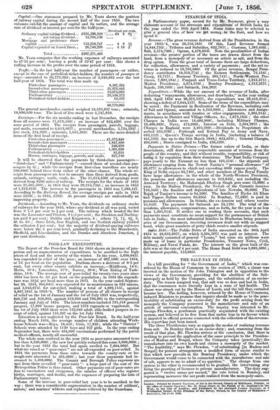RAILWAYS.
iiecent Patiiameutary returns, and some statistics compiled by Mr. J. S. Yeats, of Warnford Court, furnish the means for throwing together some interesting facts regarding th.e Railways of the united Xing:ion; and ishoWing the progress they aro making in the development of traffic. Capital.—One statement prepared by Mr. Yeats shows the position of railway capital during the second half of the year 1855. The two columns exhibit the amount of capital and its nature, and the average rate of dividend or interest per cent for the half-year.
Dividend per cent. Ordinary capital taking dividend £135,536,229 £4 2 91 not taking dividend 12,784,130 Mortgage and preference share capital 112,210,747 .... 4 8 11 Capital expended on leased lines 26,740,299 .... 4 18 2 Total £287,271,405 Mr. Yeats computes that the working expenses of railways amounted to 47-53 per, cent ; leaving a profit of 5247 per cent : this shows a trifling increase in the profits over the same period of 1854.
Trafte.—In the last half-year the number of passengers—or rather, except in the case of periodical-ticket-holders, the number of passages or trips—amounted to 06,779,985; an increase of 5,940,682 over the last half-year of 1854. The total was thus made up.
First-class passengers 8,567,524 Second-class passengers 21,976,443 Third-class passengers 13,074,093 Parliamentary 23,148,372 Periodical-ticket-holders 14,553 66,779,985 The general merchandise carried weighed 12,335,827 tons ; minerals, 18,090,030 tons. The head of live stock were 4,747,810. • Earnings.—For the six months ending in last December, the receipts from all sources were 11,613,5501.; an increase of 822,429/. over the same period of 1854. The receipts from passengers, parcels,.. luggage, and mails, amounted to 6,013,607!.; general merchandise, 3,724,2921. ; live stock, 224,2691.; minerals, 1,651,382/. These are the more detailed items of the first head of receipt. First-class passengers £1,575,649 - Second-class passengers 1,847,690 Third-class passengers 546,670 Parliamentary 1,301,026 Periodical-ticket-holders 81,654 Horses, carriages, luggage, parcels, and mails 627,140 It will be observed that the payments by • third-class passengers- " third-class" and "Parliamentary"—exceed those of second-class pas- sengers by 61.; while the receipts from first-class travellers are nearly 300,000/. behind those from either of the other classes. The whole re- ceipts from passengers are less in amount than those derived from goods, animals, carriages, mails, coals, &c. • The 11,613,550/. of earnings were derived from 8296 miles of railway. The receipts, for the whole of 1855 were 21,507,599!.; in 1854 they were 20,215,7241.; an increase in 1855 of 1,219,8751. The increase in the. passengers in 1865 was 7,388,427. According to the Rae/mite Record, the average receipts per mile in 1854 were .2510!.; in 1855, 25921. At present railways are undoubtedly an improving property. .
Dividends.—According to Mr. Yeats, the dividends on ordinary stocks of railways.for the year 1855, where any dividend at all was paid, varied from 9 1-5 per cent to t- per cent. The railway which headed the list was the Lancaster and Preston, 91-5 percent; the Stockton and Darling- ton paid 9 per cent ; Dublin and Kingstown, 8; others 7, 7, 6;1, 6, 51. 6s. 6d.;. three Irish, four English, and one Scottish rarisiny, yielded the orthodox 5 per cent; but the majority of dividend-paying railways were below • the 5 per tent level, gradually declining to the Manchester, Sheffield, and Lincolnshire, and the Dundee and Aberdeen Junction, per cent dividends.



































 Previous page
Previous page